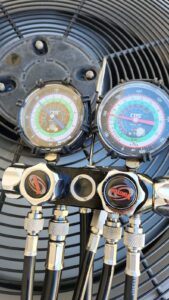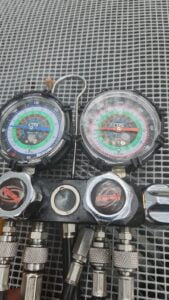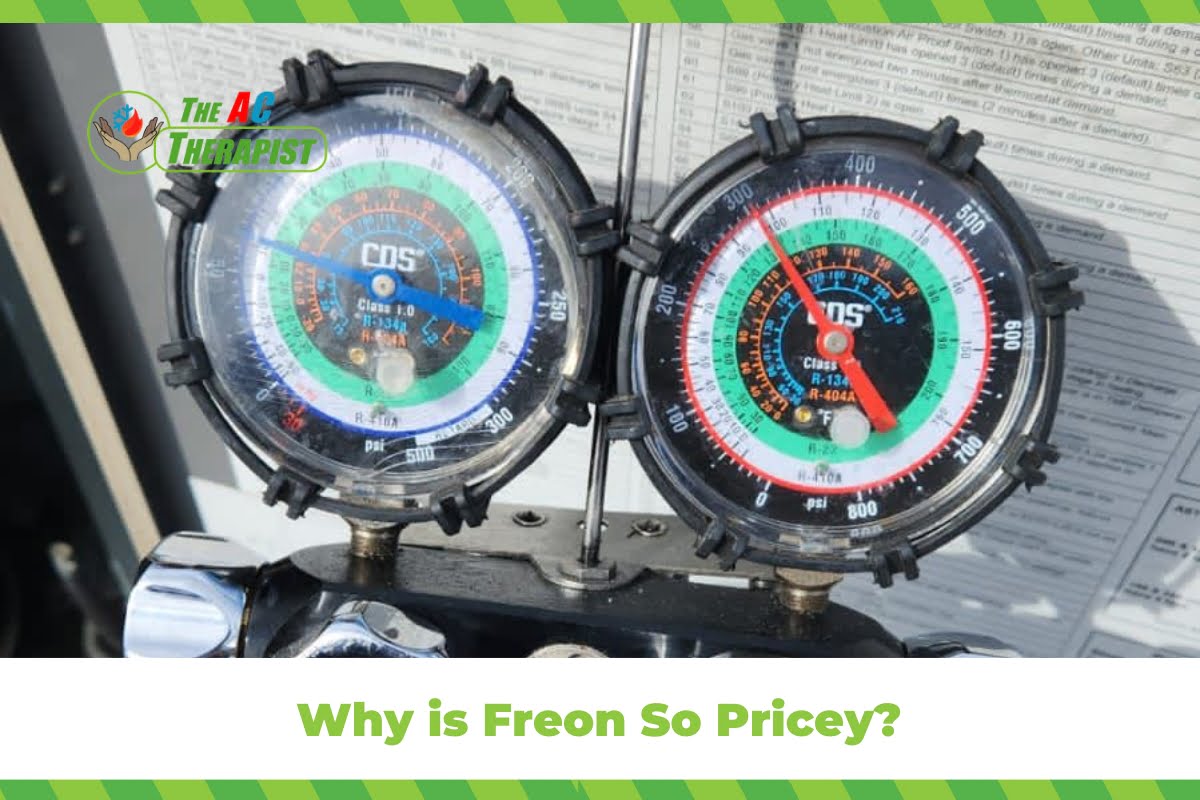Why is Freon So Pricey?
Freon has long been a household name in the air conditioning world. It’s the cooling agent found in most residential and commercial AC systems, crucial in keeping our environments comfortable. However, homeowners and business owners alike have noticed a significant increase in the cost of Freon over the years. This price rise has left many wondering why this essential component of their air conditioning systems has become so expensive. In this blog, we’ll explore the various factors contributing to the high cost of Freon.
Understanding Freon and Its Role in Air Conditioning
Freon is a term that has become synonymous with refrigerants in general, but it specifically refers to a family of chemicals used in air conditioning, refrigeration, and aerosol propellants. These chemicals are chlorofluorocarbons (CFCs), hydrochlorofluorocarbons (HCFCs), and related compounds. Freon plays a critical role in air conditioning systems, and understanding its function and characteristics is essential for anyone involved in HVAC maintenance, repair, or installation.
What is Freon?
Freon is a brand name owned by The Chemours Company, which was a part of DuPont. The name has been used for various halocarbon products, but in the context of air conditioning, it usually refers to a type of refrigerant. The most common types of Freon used in air conditioning systems have been R-22 (an HCFC) and more recently, R-410A, which is a hydrofluorocarbon (HFC) and does not deplete the ozone layer.
How Does Freon Work in Air Conditioning?
Air conditioning systems work on the principle of heat transfer. In simple terms, they remove heat from inside a building and transfer it outside. Freon, or the refrigerant, is the medium that carries this heat. The process involves several key steps:
- Compression: The air conditioning cycle begins with the compressor, which compresses the refrigerant, raising its temperature and pressure.
- Condensation: The hot, high-pressure refrigerant then flows through the condenser coils. Here, it releases its heat to the outside air. As it loses heat, the refrigerant condenses from a gas to a liquid.
- Expansion: The liquid refrigerant, still under high pressure, passes through an expansion valve. The valve reduces the pressure, causing the refrigerant to cool rapidly and evaporate into a low-temperature, low-pressure gas.
- Evaporation: This cold refrigerant then flows through the evaporator coils. As indoor air blows over these coils, the refrigerant absorbs heat from the air, cooling it. The refrigerant evaporates, turning back into a low-pressure gas.
- The cycle repeats as the low-pressure gas returns to the compressor.

The Environmental Impact and Regulatory Changes
The impact of certain refrigerants, commonly known as Freon, on the environment has been a subject of significant concern and regulatory action over the past few decades. Understanding these environmental impacts and the subsequent regulatory changes is crucial for anyone involved in the HVAC industry, as well as for homeowners and businesses relying on air conditioning and refrigeration systems.
The Ozone Layer and Refrigerants
The primary environmental concern with some types of Freon, particularly chlorofluorocarbons (CFCs) and hydrochlorofluorocarbons (HCFCs), is their contribution to the depletion of the ozone layer. The ozone layer is a stratospheric layer that protects the Earth from harmful ultraviolet (UV) radiation. When CFCs and HCFCs are released into the atmosphere, they eventually reach the stratosphere, where they are broken down by UV radiation, releasing chlorine atoms. These chlorine atoms react with ozone (O3), depleting the ozone layer.
The Montreal Protocol
In response to the scientific discovery of the ozone-depleting potential of CFCs and HCFCs, the international community adopted the Montreal Protocol on Substances that Deplete the Ozone Layer in 1987. This landmark agreement aimed to phase out the production and consumption of ozone-depleting substances (ODS). The protocol has been revised several times, with amendments and adjustments to accelerate the phase-out schedules in response to evolving scientific understanding and technological developments.
Phasing Out R-22 and Other HCFCs
One of the most widely used HCFCs in air conditioning systems has been R-22. Under the Montreal Protocol, developed countries agreed to phase out HCFCs in stages, with a complete ban on R-22 production and importation taking effect in 2020. This phase-out has led to a significant reduction in the availability of R-22, contributing to its increased cost and encouraging the transition to alternative refrigerants.
Transition to Eco-Friendly Refrigerants
The phase-out of ozone-depleting refrigerants has spurred the development and adoption of more environmentally friendly alternatives. These include hydrofluorocarbons (HFCs) like R-410A, which do not deplete the ozone layer. However, it’s important to note that while HFCs are better for the ozone layer, some have high global warming potential (GWP), leading to concerns about their impact on climate change.
The Kigali Amendment and Future Trends
Recognizing the climate impact of HFCs, the international community adopted the Kigali Amendment to the Montreal Protocol in 2016, which aims to phase down the production and consumption of HFCs. The amendment represents a significant global effort to combat climate change by reducing the emission of greenhouse gases.
The HVAC industry is now focusing on the next generation of refrigerants, which have lower GWP. These include hydrofluoroolefins (HFOs) and natural refrigerants like ammonia, carbon dioxide, and hydrocarbons. These alternatives offer a more sustainable solution for air conditioning and refrigeration, balancing the need for effective cooling with environmental responsibility.
The Economics of Supply and Demand
The economics of supply and demand play a pivotal role in understanding the pricing and availability of Freon (refrigerants) in the HVAC industry. This concept is particularly relevant in the context of the phase-out of certain types of refrigerants, such as R-22, a commonly used HCFC (hydrochlorofluorocarbon). The interplay between supply and demand significantly influences the cost and accessibility of these essential components in air conditioning systems.
Supply Constraints Due to Environmental Regulations
As part of the global initiative to protect the ozone layer and reduce greenhouse gas emissions, production and importation of ozone-depleting refrigerants like R-22 have been drastically reduced under international agreements like the Montreal Protocol and its subsequent amendments. This regulatory action has led to a significant decrease in the supply of R-22 and other similar refrigerants.
Persistent Demand for Older Refrigerants
Despite the reduction in supply, there remains a substantial demand for R-22 and other HCFCs, primarily due to the large number of existing air conditioning systems that were designed to use these refrigerants. Many of these systems are still in operation and require R-22 for maintenance and recharging. The cost of retrofitting or replacing these systems can be prohibitive for some homeowners and businesses, leading to continued demand for the refrigerant.
Price Increases
The basic economic principle of supply and demand dictates that when supply decreases and demand remains steady or decreases at a slower rate, prices generally increase. This has been the case with R-22 and other phased-out refrigerants. As the available supply dwindles due to production restrictions, prices have risen significantly. This increase in cost can be a burden for consumers needing to service older air conditioning systems that rely on these refrigerants.
Impact on Consumers and the HVAC Industry
The rising cost of R-22 and similar refrigerants has several implications for consumers and the HVAC industry. For consumers, especially those with older AC systems, the high cost of replenishing refrigerant can make maintenance more expensive. In some cases, it may even prompt the decision to replace an older system with a newer, more environmentally friendly, and energy-efficient model.

Costs Associated with Handling and Disposal
The handling and disposal of Freon (refrigerants) in air conditioning systems involve specific costs that are significant for both HVAC professionals and consumers. Proper handling and disposal are crucial due to the environmental impact of these substances, particularly those that are ozone-depleting or have high global warming potential. The costs associated with these processes are influenced by regulatory requirements, specialized equipment, and the expertise needed to ensure safe and environmentally responsible practices.
Regulatory Compliance
Compliance with environmental regulations is a primary factor driving the costs associated with the handling and disposal of refrigerants. In many countries, including the United States, regulations under the Environmental Protection Agency (EPA) mandate specific procedures for the recovery, recycling, or disposal of refrigerants. These regulations are designed to minimize the release of harmful substances into the atmosphere and to promote the responsible use of refrigerants.
HVAC professionals must adhere to these regulations, which often involve investing in training and certification. The cost of obtaining and maintaining certification, along with staying updated on regulatory changes, contributes to the overall expenses in refrigerant management.
Recovery and Recycling Equipment
The proper recovery and recycling of refrigerants require specialized equipment. This equipment must meet certain standards to ensure that refrigerants are recovered without leakage and are either recycled for reuse or safely contained for disposal. The cost of purchasing, maintaining, and operating this equipment is a significant part of the handling process.
Recovery machines, recycling units, storage cylinders, and other related tools represent a substantial investment for HVAC businesses. Additionally, the need for regular maintenance and calibration of this equipment adds to the operational costs.
Safe Disposal
When refrigerants cannot be recycled and reused, they must be disposed of properly. The disposal process for refrigerants, especially those that are ozone-depleting or have high global warming potential, is strictly regulated. Specialized facilities are required to handle the disposal of these substances, ensuring that they do not harm the environment.
The transportation of used refrigerants to disposal facilities, along with the disposal process itself, incurs costs. These expenses are often passed on to consumers as part of the service fees for maintaining, repairing, or replacing air conditioning systems.
Labor and Expertise
The handling and disposal of refrigerants require skilled labor. Technicians must be trained not only in the technical aspects of HVAC systems but also in the safe and compliant handling of refrigerants. The cost of training, along with the labor involved in recovering, recycling, and disposing of refrigerants, contributes to the overall service costs.
Environmental Impact Fees
In some regions, environmental impact fees are imposed on the use and disposal of certain refrigerants. These fees are intended to offset the environmental impact of these substances and to fund environmental protection initiatives. Such fees add to the cost of refrigerant handling and disposal.
The Shift to Alternative Refrigerants from Freon
The HVAC industry’s ongoing transition from traditional Freon-based refrigerants to more environmentally friendly alternatives marks a significant shift in both technology and environmental responsibility. This change is primarily driven by the need to reduce the harmful environmental impacts associated with certain types of Freon, particularly those that deplete the ozone layer or contribute significantly to global warming.
Understanding the Environmental Impact of Freon
Freon, a term commonly used to refer to a group of refrigerants, has been a staple in air conditioning and refrigeration systems for decades. However, certain types of Freon, such as chlorofluorocarbons (CFCs) and hydrochlorofluorocarbons (HCFCs), have been found to have detrimental effects on the ozone layer. The most notable of these, R-22 (a type of HCFC), has been widely used in air conditioning systems but is now being phased out due to its ozone-depleting properties.
The Global Response to Freon’s Environmental Impact
The international community’s response to the environmental impact of Freon led to the Montreal Protocol, an agreement to phase out ozone-depleting substances, including certain types of Freon. This agreement has been pivotal in reducing the use of harmful refrigerants and has set the stage for the development and adoption of more sustainable alternatives.
Transitioning Away from Freon to Alternative Refrigerants
As the HVAC industry moves away from Freon-like R-22, several alternative refrigerants have emerged. These alternatives are designed to minimize environmental harm while maintaining or improving the efficiency of air conditioning and refrigeration systems. Some of the key alternatives include:
- R-410A: This refrigerant, which does not deplete the ozone layer, has become one of the primary replacements for Freon in newer air conditioning systems. While R-410A is an improvement over R-22 in terms of ozone depletion, it still has a high global warming potential.
- R-32: Gaining popularity due to its lower global warming potential compared to R-410A, R-32 is another HFC refrigerant that serves as a more environmentally friendly alternative to traditional Freon.
- Hydrofluoroolefins (HFOs): These refrigerants, including R-1234yf, offer significantly lower global warming potential than traditional Freon and are becoming more common in various applications.
- Natural Refrigerants: Substances like ammonia, carbon dioxide, and hydrocarbons (propane and isobutane) are natural alternatives to Freon. They have minimal impact on ozone depletion and global warming but come with their own set of handling and safety considerations.
Challenges in Moving Away from Freon
The shift away from Freon to alternative refrigerants is not without challenges. Compatibility with existing systems, the need for new servicing equipment and techniques, and the training of HVAC technicians are significant considerations. Additionally, some of the alternatives, while environmentally friendlier, may have other drawbacks such as flammability or higher operating pressures.
The Future Beyond Freon
As the HVAC industry continues to innovate and evolve, the move away from traditional Freon refrigerants is expected to accelerate. This transition supports global environmental goals and aligns with increasing consumer demand for sustainable and eco-friendly cooling solutions. The future of air conditioning and refrigeration is likely to see a continued focus on developing and implementing refrigerants that offer a balance between environmental safety, efficiency, and practicality.

Understanding the Rising Costs with The AC Therapist
To wrap up, the escalating cost of Freon in air conditioning systems is a complex issue with multiple layers. Throughout this blog, we’ve delved into the various factors contributing to this trend, including stringent environmental regulations, the global phase-out of ozone-depleting substances, the economics of supply and demand, the expenses associated with the proper handling and disposal of refrigerants, and the industry’s shift towards more sustainable and eco-friendly alternatives.
At The AC Therapist, we are acutely aware of the challenges and concerns that arise from the increasing costs associated with Freon. Our commitment to our clients in the Tampa Bay area extends beyond mere service provision; we aim to be your trusted partner in navigating these evolving dynamics in the HVAC industry. Whether it involves maintaining and servicing existing systems that utilize Freon or assisting you in transitioning to newer, more environmentally responsible refrigerants, our team of experts is equipped with the knowledge and skills to guide you every step of the way.
We understand that dealing with air conditioning issues, particularly those related to the cost and availability of refrigerants like Freon, can be overwhelming. However, with The AC Therapist by your side, you have access to a wealth of expertise and support. Our goal is to ensure that your air conditioning system is not only functioning optimally but also aligns with the latest environmental standards and is cost-effective in the long run.
For those in the Tampa Bay area grappling with the high cost of Freon or considering an upgrade to a more modern and efficient air conditioning system, The AC Therapist is here to help. Our team is dedicated to providing top-notch service and advice, ensuring that your cooling needs are met with the utmost professionalism and care. Reach out to us for any inquiries or assistance, and let us be your guide to a cooler, more sustainable, and economically sensible air conditioning future.








